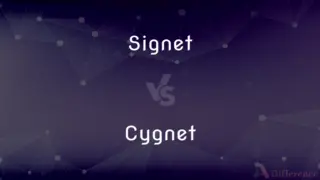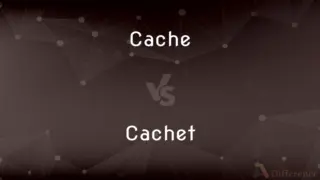Emoji vs. Emoticon — What's the Difference?
By Maham Liaqat & Urooj Arif — Updated on April 25, 2024
Emoji are colorful symbols representing objects or feelings, widely used in digital communication, while emoticons are textual representations of facial expressions, often created from keyboard characters.
Difference Between Emoji and Emoticon
Table of Contents
ADVERTISEMENT
Key Differences
Emoji are visual icons that come in a standardized set, making them universally recognizable across different platforms. Whereas, emoticons are a creative assembly of punctuation marks, letters, and numbers to convey emotions and are more style-dependent.
Emoji can depict a wide range of real-world objects, animals, and symbols beyond just emotions. On the other hand, emoticons primarily focus on conveying facial expressions and are limited by the creativity and the characters available on a user's device.
Emoji are integrated into digital keyboards with specific codes behind each symbol, which translates the same across different devices and platforms. In contrast, emoticons can vary in appearance from one platform to another, depending on how text is rendered.
Emoji often receive updates to include more diversity and new icons, reflecting cultural trends and inclusivity. Whereas, emoticons, being user-generated from standard keyboard characters, do not have an updating governing body.
Emoji are supported by Unicode which means they look the same across many devices globally. Meanwhile, emoticons can be misinterpreted between different users or platforms, depending on individual text settings and interpretations.
ADVERTISEMENT
Comparison Chart
Nature
Graphical symbols
Text-based facial expressions
Variety
Wide, including objects, symbols, and expressions
Primarily facial expressions
Standardization
Unicode standardization
No standardization; varies by user creativity
Platform Consistency
Consistent appearance across platforms
Appearance can vary across platforms
Updates
Regularly updated
Static, no official updates
Compare with Definitions
Emoji
A digital icon used to express emotions or concepts.
The thumbs-up emoji is used to show approval.
Emoticon
Text-based symbols used to convey emotions in digital messages.
She used the emoticon :-( to show she was sad.
Emoji
Symbols in texting that convey emotional cues.
She sent a heart emoji to show her love.
Emoticon
A representation of a facial expression using keyboard characters.
The emoticon :-) denotes a smile.
Emoji
A small digital image used to express an idea.
Use the pizza emoji when asking if someone wants to order pizza.
Emoticon
Created by users using characters available on a keyboard.
An astonished face can be made with :-O.
Emoji
Emoji are often colorful and standardized.
The red heart emoji signifies love.
Emoticon
Reflects creativity in textual form.
He cleverly crafted a wink with ;-).
Emoji
Used in digital communications to add flair or emotion.
He ended his happy birthday wish with a cake emoji.
Emoticon
Lacks the variety and color of emojis.
Emoticons are usually just plain text.
Emoji
Emoji or Emojis ( i-MOH-jee; from Japanese 絵文字 [emodʑi] lit. 'picture character'; plural emoji or emojis) are pictograms, logograms, ideograms and smileys used in electronic messages and web pages. The emoji's primary function is to fill in emotional cues otherwise missing from typed conversation.
Emoticon
An emoticon (, ə-MOH-tə-kon, rarely pronounced ), short for "emotion icon", also known simply as an emote, is a pictorial representation of a facial expression using characters—usually punctuation marks, numbers, and letters—to express a person's feelings, mood or reaction, or as a time-saving method. Early emoticons were the precursors to modern emojis, which are ever-developing predominantly on iOS and Android devices.
Emoji
A small digital image or icon used to express an idea or emotion
Emoji liven up your text messages with tiny smiley faces
Emoticon
A representation of a facial expression such as a smile or frown, formed by various combinations of keyboard characters and used to convey the writer's feelings or intended tone
Flag your jokes with emoticons, such as a smiley face :-), to avoid misunderstandings
Emoji
A standardized ideogrammatic icon, as of a face or a heart, used especially in electronic messages or on webpages.
Emoticon
A facial glyph, used especially in email, texts, and instant messages and sometimes typed sideways, that indicates an emotion or attitude, as [ :-) ] to indicate delight, humor, or irony or [ :'( ] to indicate sadness.
Emoji
Such icons considered collectively.
Emoticon
A graphical representation of a particular emotion of the writer, used especially in SMS, email, or other electronic communication.
Emoji
A digital graphic icon with a unique code point used to represent a concept, object, person, animal or place, originally used in Japanese text messaging but since adopted internationally in other contexts such as social media. Or, by extension, any non-standard emoji-like image inserted inline in text, i.e. an image emoticon.
Emoticon
A graphic made up of text characters to represent such emotion; a smiley.
Emoticon
An image or graphic icon used to represent such emotions; an emoji.
Emoticon
A representation of a facial expression (as a smile or frown) created by typing a sequence of characters in sending email;
:-( and :-) are emoticons
Common Curiosities
Can emoticons be used on any digital platform?
Yes, emoticons can be used on any platform that supports text input, but their appearance may vary.
What is an emoji?
An emoji is a graphical icon used in digital communications to express emotions, activities, or concepts.
What is an emoticon?
An emoticon is a textual representation of a facial expression, formed using characters from a standard keyboard.
How often are new emoji released?
New emoji are released periodically as part of Unicode updates.
Do emoticons have a standard set?
No, there is no official standard for emoticons; they are created based on user creativity.
Are emoji universally the same across devices?
Yes, due to Unicode standardization, emoji appear consistently across different devices and platforms.
How are new emoji decided?
The Unicode Consortium reviews and approves new emoji based on proposals from the public and other stakeholders.
How do emoji differ from emoticons in appearance?
Emoji are colorful and standardized images, whereas emoticons are made from text and lack color.
Why might someone choose to use an emoticon over an emoji?
Some prefer emoticons for their simplicity and retro appeal, or because they allow for more personalized expression.
Are all emoji expressions?
No, emoji can also represent objects, symbols, and actions, not just emotional expressions.
Share Your Discovery

Previous Comparison
Signet vs. Cygnet
Next Comparison
Cache vs. CachetAuthor Spotlight
Written by
Maham LiaqatCo-written by
Urooj ArifUrooj is a skilled content writer at Ask Difference, known for her exceptional ability to simplify complex topics into engaging and informative content. With a passion for research and a flair for clear, concise writing, she consistently delivers articles that resonate with our diverse audience.














































